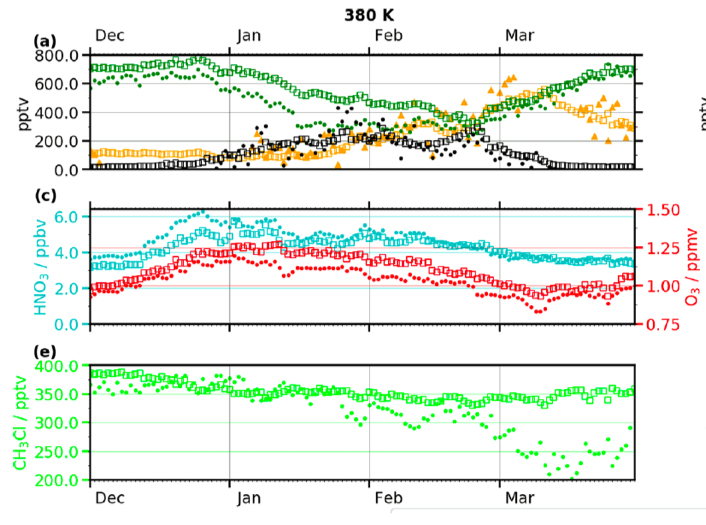Low temperatures in the 2015/16 winter lower stratosphere give rise to polar stratospheric cloud (PSC) formation, denitrification/dehydration, chlorine activation, and chemical ozone loss. These processes have been much less studied in the tropopause region / lowermost stratosphere (LMS). High spatial resolution measurements of the LMS were obtained by the PGS aircraft campaign, conducted during the extremely cold Arctic winter.
Trace gas measurements made on three flights in January, February, and March 2016 by the GLORIA airborne limb imager are analyzed in conjunction with model simulations to investigate chlorine partitioning in the LMS. Observations from the Aura Microwave Limb Sounder (MLS) and other satellite instruments provide spatial and temporal context for GLORIA data and connect them to stratospheric conditions above the flight altitude. The satellite measurements reveal unusually low HCl and ClONO2 and strongly enhanced ClO at 380 K in January and February, leading to large ozone depletion (~0.4 ppmv) at that level. In March, very low ozone values resulted in abnormally rapid reformation of HCl rather than ClONO2 (the more typical chlorine deactivation pathway in the Arctic).

MLS (and ACE-FTS) measurements illustrate the exceptional conditions in the LMS (380 K, ~15 km) during the Arctic winter of 2015/16: extremely low vortex-averaged HCl (and ClONO2) and enhanced ClO indicate strong chlorine activation, with very low ozone values as a result of unusually severe chemical loss at this level. A Lagrangian chemistry transport model (CLaMS) generally reproduces the atypical behavior in the LMS, although it underestimates HCl activation (a common model problem), as well as the increase in HNO3 in early winter arising from renitrification by PSC particles sedimenting from above; differences with observed CH3Cl indicate that modeled diabatic descent inside the polar vortex is too weak.
Technical description of figure:
Figure 4 of above reference. Time series over the Arctic winter of vortex-averaged trace gases from satellite measurements and CLaMS simulations at 380 K (~15 km in January). CLaMS data are shown as open squares, MLS as filled points, and ACE-FTS as triangles. The evolution of chlorine species (ClONO2: orange; HCl: green; ClO: black) is illustrated in the first row, HNO3 (cyan) and O3 (red) in the second row, and CH3Cl (light green) in the third row. The approximate boundary of the vortex was defined using MERRA-2 scaled potential vorticity (sPV < 1.2 × 10-4 s-1).
Scientific significance, societal relevance, and relationships to future missions:
The LMS region is strongly influenced by dynamical effects, such as transport, mixing, wave propagation, and subsidence, and it undergoes a large degree of variability. Vertically resolved measurements are needed to quantify polar processes such as chlorine activation / deactivation, denitrification and dehydration, and chemical ozone loss in the dynamically complex conditions of the LMS, as well as to validate the results of atmospheric chemistry–climate and transport models there. With climate change, exceptionally cold winters are expected to occur more frequently, particularly in the Arctic LMS. Thus the results of this study underscore the need for continued monitoring of vertically resolved profiles of ozone and associated trace gases to detect and understand variability and trends in the LMS region. Although vertically resolved limb measurements of O3 will be continued by the Ozone Mapper and Profiler Suite Limb Profiler (OMPS-LP) scheduled for launch on the Joint Polar Satellite System (JPSS)-2 spacecraft in 2022, no concrete plans for future measurements of HCl, ClO, or other chlorine species of relevance to stratospheric ozone chemistry (by NASA or other agencies) currently exist.
Data sources:
GLORIA (Gimballed Limb Observer for Radiance Imaging of the Atmosphere) measurements of temperature, O3, HNO3, ClONO2, H2O, and CFC-12 obtained during the POLSTRACC/GW-LCYCLE II/GWEX/SALSA (PGS) campaign, available from the HALO database at https://doi.org/10.17616/R39Q0T. Aura Microwave Limb Sounder (MLS) version 4.2 measurements of O3, HNO3, HCl, ClO, and CH33Cl, available from http://disc.sci.gsfc.nasa.gov/Aura/data-holdings/MLS/index.shtml. SCISAT Atmospheric Chemistry Experiment–Fourier Transform Spectrometer (ACE-FTS) version 3.5 and 3.6 measurements of ClONO2, available from https://databace.scisat.ca/level2/. CALIPSO (Cloud-Aerosol Lidar and Infrared Pathfinder Satellite Observations) Cloud-Aerosol Lidar with Orthogonal Polarization (CALIOP) measurements of polar stratospheric clouds. Simulated fields from the Chemical Lagrangian Model of the Stratosphere (CLaMS) and the ECHAM5/MESSy Atmospheric Chemistry (EMAC) model, driven by European Centre for Medium-Range Weather Forecasts (ECMWF) reanalyses or operational analyses, available upon request from the authors. Modern-Era Retrospective analysis for Research and Applications, Version 2 (MERRA-2), available from https://doi.org/10.5067/A7S6XP56VZWS.
References: Johansson, S., M.L. Santee, et al., Unusual chlorine partitioning in the 2015/16 Arctic winter lowermost stratosphere: observations and simulations, Atmos. Chem. Phys., 19, 8311–8338, doi:10.5194/acp-19-8311-2019, 2019.
9.2019